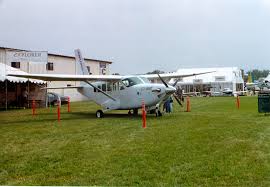Aircraft Technical Data
AEA Explorer

| Details | |
| Country of Origin | Australia |
| Type | Multirole utility transport |
| History | The AEA Explorer 350R is a nine-place Australian utility aircraft developed by Aeronautical Engineers Australia Research Pty Ltd (AEA). It is designed to fill a market gap between the Cessna 206 Stationair and the much larger Cessna 208 Caravan utility singles. AEA's managing director Graham Swannell first began looking at a new utility aircraft in the late 1980s, and initially considered developing a stretched and more powerful Cessna 206 conversion which would have been covered by a supplemental type certificate. But by 1993 Swannell had started design work on an all new aircraft, a 10 seater powered by an eight cylinder 300kW (400hp) Textron Lycoming IO-720. This design then evolved to become the Explorer 350R, a nine-seater powered by a Teledyne Continental TSIO-550 flat-six. The 350R flew for the first time on January 23 1998. Apart from its TSIO-550 engine driving a three blade prop, design features include a metal frame fuselage with a carbonfibre shell, conventional all metal wings and tail surfaces and retractable undercarriage. The main undercarriage retraction system is uncommon - the legs, which are made from fibreglass, extend further downwards before crossing each other below the fuselage with the wheels coming to rest in pods on the opposite side of the fuselage - thus not intruding into the main cabin. The aircraft's basic configuration is optimised for its intended utility roles, with a high mounted, braced wing, rectangular and constant section, flat floor cabin, and large cabin windows. The Explorer 350R will not be built in series, but is the proof-of-concept (POC) prototype for a family of utility aircraft. The 350R prototype was converted to the 500T prototype, powered by a 600shp Pratt & Whitney PT6A-135B turboprop, and the first flight as such was made on June 9 2000. The 500T has seating for eleven (including the pilot) in a passenger configuration, and will be the entry level aircraft for the Explorer. A second production version will be the 500R, a 600hp Orenda OE-600A piston engine powered version of the 500T. A 2.21m (7ft 3in) stretched version is planned, the Explorer 750T, which will seat 17 (including the pilot), and will be powered by a 750shp Pratt & Whitney PT6A-60A turboprop. On May 20 1999 the 350R left Australia for a promotional tour of the USA, and will now be further developed and taken into production in the United States by Explorer Aircraft Inc, located in Jasper, Texas. |
| Powerplants | 350R - One 260kW (350hp) Teledyne Continental TSIO-550-E3B turbocharged and fuel injected flat-six piston engine driving a three-blade Hartzell propeller. 500T - One 447kW (600shp) Pratt & Whitney Canada PT6A-135B turboprop driving a four-blade propeller |
| Performance | 350R - Max cruising speed 278km/h (150kt). Initial rate of climb 750ft/min. Takeoff run 366m (1200ft). Service ceiling 25,000ft. Max range with reserves 1852km (1000nm). Endurance over 3hr. 500T - Cruising speed 333km/h (180kt). Initial rate of climb 1000ft/min. Takeoff run 366m (1200ft). Service ceiling 25,000ft. Max range with reserves 1759km (950nm). |
| Weights | 350R - Empty 1360kg (3000lb), max takeoff 2177kg (4800lb). 500T - Empty 1723kg (3800lb), max takeoff 2812kg (6200lb) |
| Dimensions | 350R - Wing span 14.43m (47ft 4in), length 9.68m (31ft 9in), height 4.72m (15ft 6in). Wing area 18.36m2 (197.6sq ft). 500T - Wing span 14.43m (47ft 4in), length 10.13m (33ft 3in), height 4.72m (15ft 6in). Wing area 18.36m2 (197.6sq ft). |
| Capacity | 350R - Seating for nine (including pilot) in a passenger configuration. Cargo volume 7.08m3 (250cu ft). 500T - Seating for eleven (including pilot) in a passenger configuration. Cargo volume 7.08m3 (250cu ft). |
| Production | One 350R, later converted to 500T (by Feb.2002) |
| Related Links | AEA Explorer |
The backbone of this section is from the The International Directory of Civil Aircraft by Gerard Frawley and used with permission. To get your own copy of the book click here. |
|








